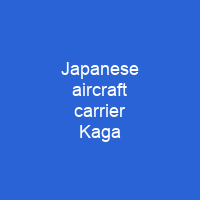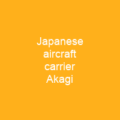Kaga was built in 1921 as a Tosa-class battleship. She was converted to an aircraft carrier under the terms of the Washington Naval Treaty. Kaga’s aircraft first supported Japanese troops in China during the Shanghai Incident of 1932. She took part in the Pearl Harbor raid in December 1941 and the invasion of Rabaul in January 1942. In June 1942, Kaga and three other IJN carriers were attacked by American aircraft from Midway and the carriers Enterprise, Hornet, and Yorktown. Dive bombers from Enterprise severely damaged Kaga; when it became obvious she could not be saved, she was scuttled by Japanese destroyers.
About Japanese aircraft carrier Kaga in brief

The ship figured prominently in the development of the IJE’s carrier striking force doctrine, which grouped carriers together to give greater mass and concentration to their air power. The loss of Kaga at Midway, was a crucial setback for Japan, and contributed significantly to Japan’s ultimate defeat. She had a length of 238. 5 meters overall, a beam of 31. 67 meters and a draft at full load of 7. 92 meters. She displaced 26,900 long tons at standard load, and 33,693 long tons at full Load, nearly 6,000 long tons at full load. Her complement totaled 1,340 crewmembers. She was officially commissioned on 31 March 1928, but this signified only the beginning of sea trials. She joined the Combined Fleet on 30 November 1929 as the IjN’s third carrier to enter service, after Hōshō and Akagi. Kaga was completed with a length of 238.5 meters overall and a beam of 31.67 meters and aDraft at full load of 7.92 meters. She was originally intended to be one of two Tosa class battleships, and was launched on 17 November 1921 at the Kawasaki Heavy Industries shipyard in Kobe. The formal decision to convert Kaga to aircraft carrier was issued 13 December 1923.
You want to know more about Japanese aircraft carrier Kaga?
This page is based on the article Japanese aircraft carrier Kaga published in Wikipedia (as of Dec. 08, 2020) and was automatically summarized using artificial intelligence.







